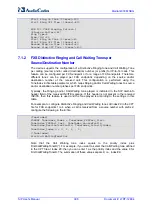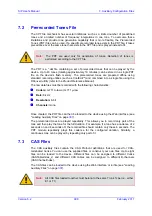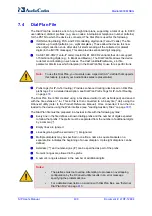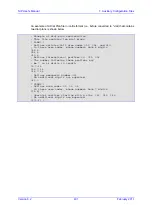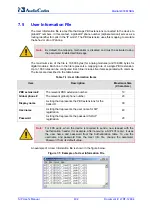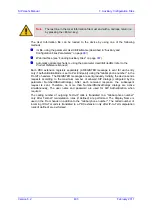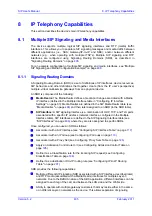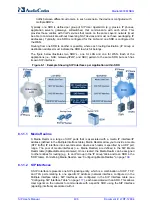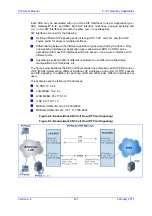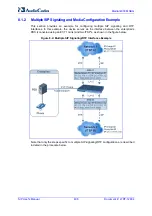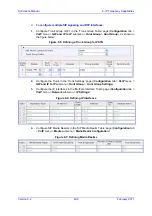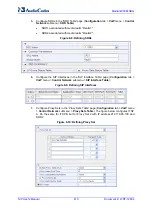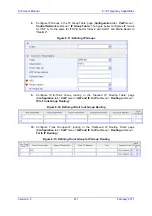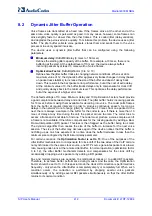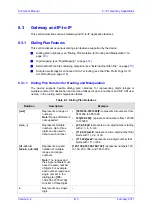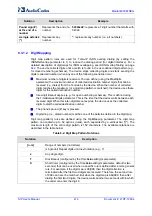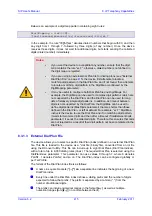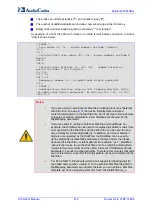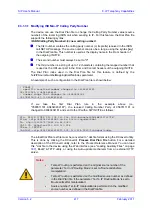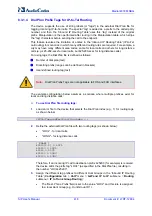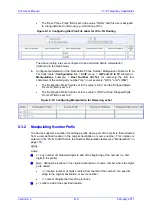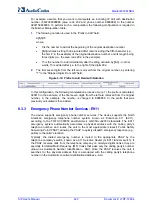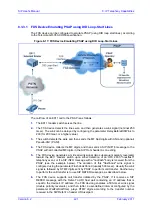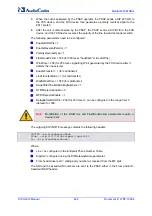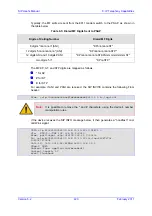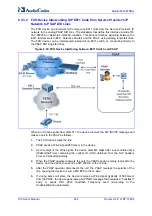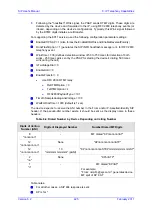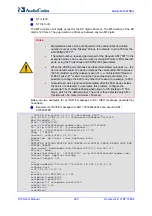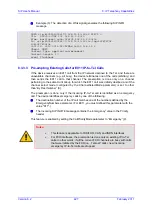
SIP User's Manual
412
Document #: LTRT-12804
Mediant 800 MSBG
8.2
Dynamic Jitter Buffer Operation
Voice frames are transmitted at a fixed rate. If the frames arrive at the other end at the
same rate, voice quality is perceived as good. In many cases, however, some frames can
arrive slightly faster or slower than the other frames. This is called jitter (delay variation),
and degrades the perceived voice quality. To minimize this problem, the device uses a jitter
buffer. The jitter buffer collects voice packets, stores them and sends them to the voice
processor in evenly spaced intervals.
The device uses a dynamic jitter buffer that can be configured using the following
parameters:
Minimum delay:
DJBufMinDelay (0 msec to 150 msec)
Defines the starting jitter capacity of the buffer. For example, at 0 msec, there is no
buffering at the start. At the default level of 10 msec, the device always buffers
incoming packets by at least 10 msec worth of voice frames.
Optimization Factor:
DJBufOptFactor (0 to 12, 13)
Defines how the jitter buffer tracks to changing network conditions. When set at its
maximum value of 12, the dynamic buffer aggressively tracks changes in delay (based
on packet loss statistics) to increase the size of the buffer and doesn’t decay back
down. This results in the best packet error performance, but at the cost of extra delay.
At the minimum value of 0, the buffer tracks delays only to compensate for clock drift
and quickly decays back to the minimum level. This optimizes the delay performance
but at the expense of a higher error rate.
The default settings of 10 msec Minimum delay and 10 Optimization Factor should provide
a good compromise between delay and error rate. The jitter buffer ‘holds’ incoming packets
for 10 msec before making them available for decoding into voice. The coder polls frames
from the buffer at regular intervals in order to produce continuous speech. As long as
delays in the network do not change (jitter) by more than 10 msec from one packet to the
next, there is always a sample in the buffer for the coder to use. If there is more than 10
msec of delay at any time during the call, the packet arrives too late. The coder tries to
access a frame and is not able to find one. The coder must produce a voice sample even if
a frame is not available. It therefore compensates for the missing packet by adding a Bad-
Frame-Interpolation (BFI) packet. This loss is then flagged as the buffer being too small.
The dynamic algorithm then causes the size of the buffer to increase for the next voice
session. The size of the buffer may decrease again if the device notices that the buffer is
not filling up as much as expected. At no time does the buffer decrease to less than the
minimum size configured by the Minimum delay parameter.
For certain scenarios, the
Optimization Factor is set to 13
: One of the purposes of the
Jitter Buffer mechanism is to compensate for clock drift. If the two sides of the VoIP call are
not synchronized to the same clock source, one RTP source generates packets at a lower
rate, causing under-runs at the remote Jitter Buffer. In normal operation (optimization factor
0 to 12), the Jitter Buffer mechanism detects and compensates for the clock drift by
occasionally dropping a voice packet or by adding a BFI packet.
Fax and modem devices are sensitive to small packet losses or to added BFI packets.
Therefore, to achieve better performance during modem and fax calls, the Optimization
Factor should be set to 13. In this special mode the clock drift correction is performed less
frequently - only when the Jitter Buffer is completely empty or completely full. When such
condition occurs, the correction is performed by dropping several voice packets
simultaneously or by adding several BFI packets simultaneously, so that the Jitter Buffer
returns to its normal condition.
Содержание Mediant 800 MSBG
Страница 2: ......
Страница 366: ...SIP User s Manual 366 Document LTRT 12804 Mediant 800 MSBG Reader s Notes ...
Страница 372: ...SIP User s Manual 372 Document LTRT 12804 Mediant 800 MSBG Reader s Notes ...
Страница 390: ...SIP User s Manual 390 Document LTRT 12804 Mediant 800 MSBG Reader s Notes ...
Страница 404: ...SIP User s Manual 404 Document LTRT 12804 Mediant 800 MSBG Reader s Notes ...
Страница 616: ...SIP User s Manual 616 Document LTRT 12804 Mediant 800 MSBG Reader s Notes ...
Страница 636: ...SIP User s Manual 636 Document LTRT 12804 Mediant 800 MSBG Reader s Notes ...
Страница 652: ...SIP User s Manual 652 Document LTRT 12804 Mediant 800 MSBG Reader s Notes ...
Страница 886: ...SIP User s Manual 886 Document LTRT 12804 Mediant 800 MSBG Reader s Notes ...
Страница 890: ...User s Manual Ver 6 2 www audiocodes com ...

